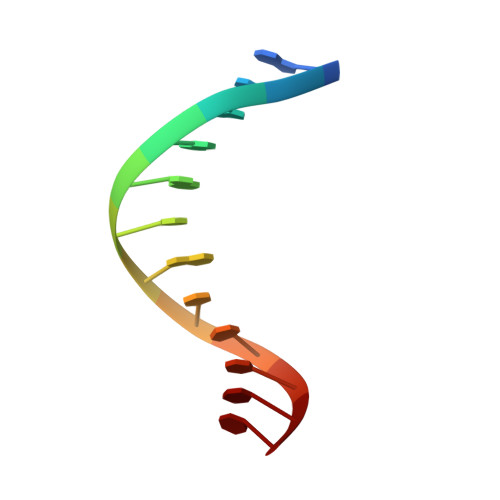Site-Specific Stabilization of DNA by a Tethered Major Groove Amine, 7-Aminomethyl-7-deaza-2'-deoxyguanosine.
Szulik, M.W., Voehler, M.W., Ganguly, M., Gold, B., Stone, M.P.(2013) Biochemistry 52: 7659-7668
- PubMed: 24131376
- DOI: https://doi.org/10.1021/bi400695r
- Primary Citation of Related Structures:
2LIA - PubMed Abstract:
A cationic 7-aminomethyl-7-deaza-2'-deoxyguanosine (7amG) was incorporated site-specifically into the self-complementary duplex d(G¹A²G³A⁴X⁵C⁶G⁷C⁸T⁹C¹⁰T¹¹C¹²)₂ (X = 7amG). This construct placed two positively charged amines adjacent to the major groove edges of two symmetry-related guanines, providing a model for probing how cation binding in the major groove modulates the structure and stability of DNA. Molecular dynamics calculations restrained by nuclear magnetic resonance (NMR) data revealed that the tethered cationic amines were in plane with the modified base pairs. The tethered amines did not form salt bridges to the phosphodiester backbone. There was also no indication of the amines being capable of hydrogen bonding to flanking DNA bases. NMR spectroscopy as a function of temperature revealed that the X⁵ imino resonance remained sharp at 55 °C. Additionally, two 5'-neighboring base pairs, A⁴:T⁹ and G³:C¹⁰, were stabilized with respect to the exchange of their imino protons with solvent. The equilibrium constant for base pair opening at the A⁴:T⁹ base pair determined by magnetization transfer from water in the absence and presence of added ammonia base catalyst decreased for the modified duplex compared to that of the A⁴:T⁹ base pair in the unmodified duplex, which confirmed that the overall fraction of the A⁴:T⁹ base pair in the open state of the modified duplex decreased. This was also observed for the G³:C¹⁰ base pair, where αK(op) for the G³:C¹⁰ base pair in the modified duplex was 3.0 × 10⁶ versus 4.1 × 10⁶ for the same base pair in the unmodified duplex. In contrast, equilibrium constants for base pair opening at the X⁵:C⁸ and C⁶:G⁷ base pairs did not change at 15 °C. These results argue against the notion that electrostatic interactions with DNA are entirely entropic and suggest that major groove cations can stabilize DNA via enthalpic contributions to the free energy of duplex formation.
- Department of Chemistry and Center for Structural Biology, Vanderbilt University , Nashville, Tennessee 37235, United States.
Organizational Affiliation:
















